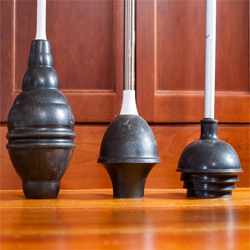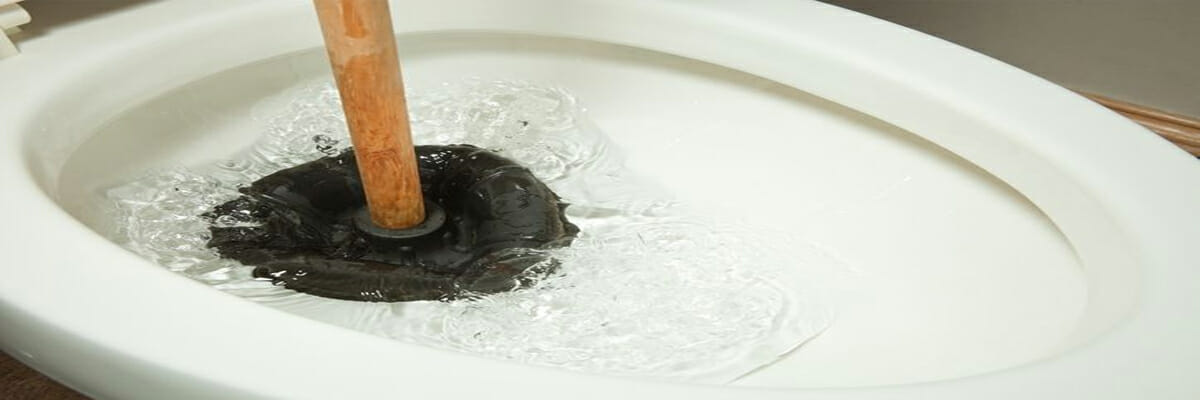If you’ve ever had a clogged toilet, you know the panic that sets in when you flush the commode and nothing happens. Most people first reach for a plunger, but sometimes, even that doesn’t do the trick.
Why won’t your toilet drain when you are using a plunger? Read on to find out.
4 Reasons Why Your Toilet Won’t Unclog With a Plunger
A plunger is usually all you need to unclog a toilet, but there are times when it just doesn’t work. Here are four reasons why your plunger may not be clearing the clogged toilet:
1. You’re Using the Wrong Plunger

Instead, you need to use a flange plunger with an extended rubber bell-shaped end that fits into the bottom of the toilet bowl. This plunger will create a better seal and provide more power to unclog the blockage.
Using the wrong plunger won’t give you the results you’re looking for. Make sure you’re using the proper one for the job at hand.
Are you looking to hire plumbing professionals that can help you out when your toilet is clogged? Check these two links below:
2. You’re Using the Plunger Incorrectly
It may seem self-evident, but there is a right way to use a toilet plunger. If you’re not using it properly, you won’t have much success in unclogging the toilet.
Here’s how to do it:
- Ensure that the extension flange lip is completely unfolded.
- Position the plunger over the drain hole at the bottom of the toilet bowl and cover it completely. If there’s any gap, the plunger won’t be able to create enough pressure to unclog the drain.
- Start with a single, gentle down-and-up stroke to prime the plunger. This push will force air from the plunger and keep it from pushing water out of the toilet bowl.
- Now, use a little more force and plunge vigorously up and down to break up the toilet clog. If you use too much power, you may break the seal and have to start over again.
- Do this for 15-30 seconds or until you feel the blockage start to give way. When the resistance begins to ease, continue plunging for a few more seconds to ensure that the clog clears.
- If this does not place the toilet in working order, repeat the process to unclog your toilet.
With these simple tips, you can ensure that your plunger will do its job effectively and without damaging your pipes.
3. The Water Level in the Bowl Is Wrong

Additionally, the weight of that extra water on top of the plunger will make it challenging to generate enough suction to unclog the drain.
On the other hand, if there is not enough water, the plunger cannot make the seal work effectively. This will prevent you from creating the suction required to eliminate most clogs. You need enough water to get a good seal.
4. The Clog is Too Far Down
If the clog is too far down, the vacuum created by the plunger may not be sufficient to dislodge it. As you are aware, a plunger can only exert a certain amount of upward force before the seal breaks.
If the clog is too far into the piping, that force may not be enough to move it from the toilet trap. In this case, you will need a plunger with more suction power or a different tool altogether.
What to Do If Your Toilet Is Still Clogged?
If your toilet plunger isn’t working, don’t despair. There are some other things you can try to unclog your toilet. They also can work on a clogged bathroom sink.
1. Vinegar and Baking Soda
One simple home remedy is to try a mixture of vinegar and baking soda. Pour one cup of baking soda into the toilet bowl, followed by two cups of vinegar.
Let the mixture sit for 15 minutes, then flush the toilet.
The vinegar and baking soda will react to create a foaming chemical reaction that can help break up the clog.
2. Hot Water and Dish Soap
Another option is to squirt a generous amount of dish soap into the bowl and wait a few minutes. Then add hot water into the toilet bowl. The soapy water’s heat can help break up the clog, making flushing easier.
Just be careful not to pour too much at once—you don’t want the hot water to splash back and burn you. Also, use hot water, not boiling, so that you do not damage the toilet bowl.
3. Household Bleach
Like dish soap, sodium hypochlorite (household bleach) can help remove clogs. Wearing rubber gloves, pour 2-3 cups of bleach into the toilet, let it sit for 10-15 minutes, then flush. The bleach will help to dissolve the clog and make it easier to remove.
4. Mechanical Snake

To use a drain snake, insert the end into the toilet bowl and start turning the handle. The snake will begin to spin as it moves down the drain, which can help break up the clog. Continue turning the handle until the end catches on something—this is likely the clog.
At this point, you can try to pull the clog out or continue turning the handle around in a spiral motion. As you move it around, the snake will loosen the clog.
Related article: 6 Ways to Unclog a Drain if a Snake Doesn’t Work
Clog Prevention
To prevent clogs in the future, make sure you never put anything other than toilet paper and waste down the toilet. Some everyday items that people try to flush but shouldn’t include cotton balls, hair, wipes, and paper towels.
When All Else Fails, Call the Plumber
When the home remedies aren’t working, it may be time to call the plumber. A professional from Damien McEvoy Plumbing will have more powerful tools and solutions to unclog a toilet all the way down to the sewer line.
Additionally, we will be able to identify any underlying issues that may be causing your clogs. These include aging pipes, tree root infiltration, and pipe collapse. By addressing the underlying problem, we can help prevent future clogs.
Call us today at (02) 8599 4593 for 24/7 plumbing services. We’re here to help!



 Enquire
Enquire